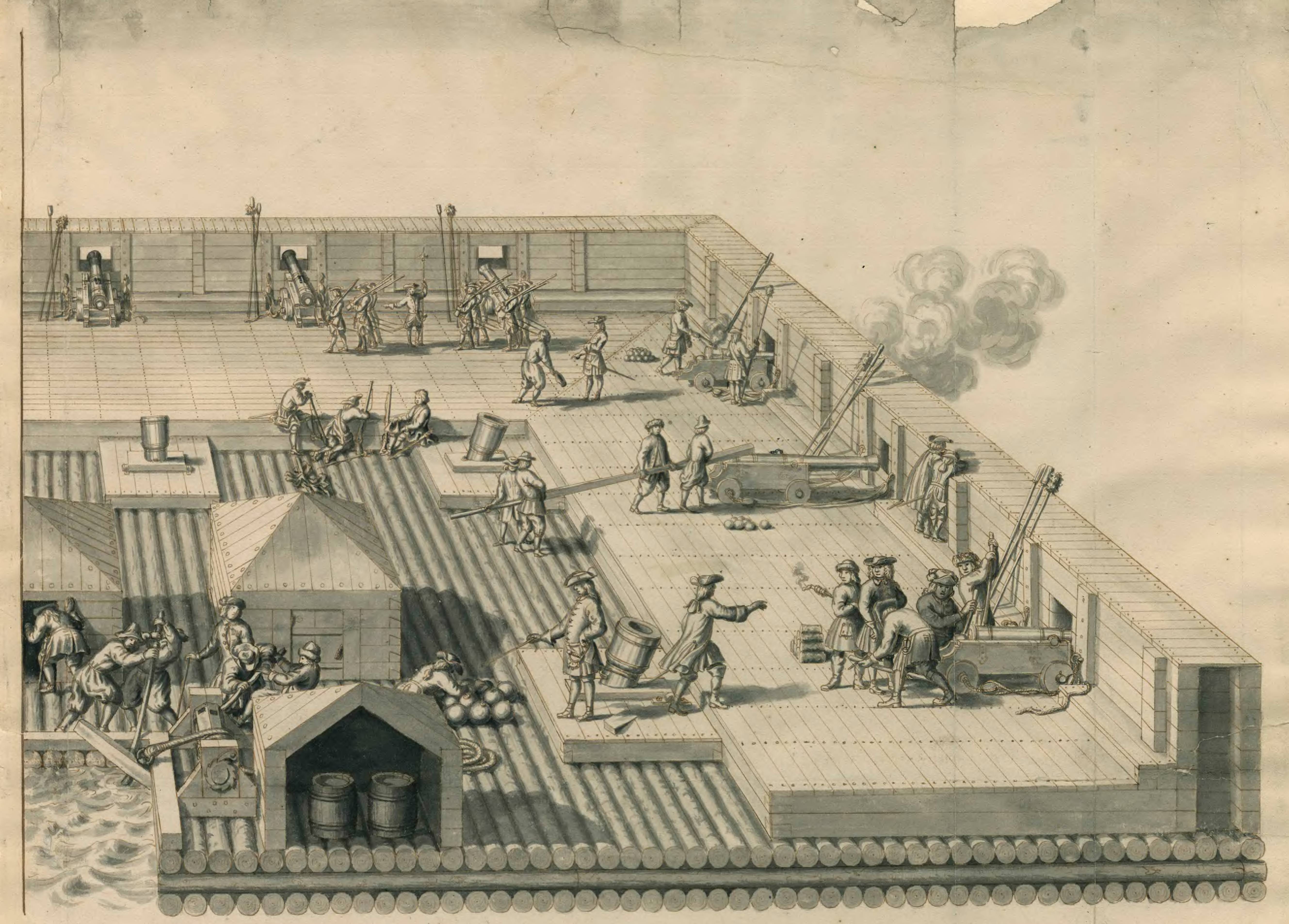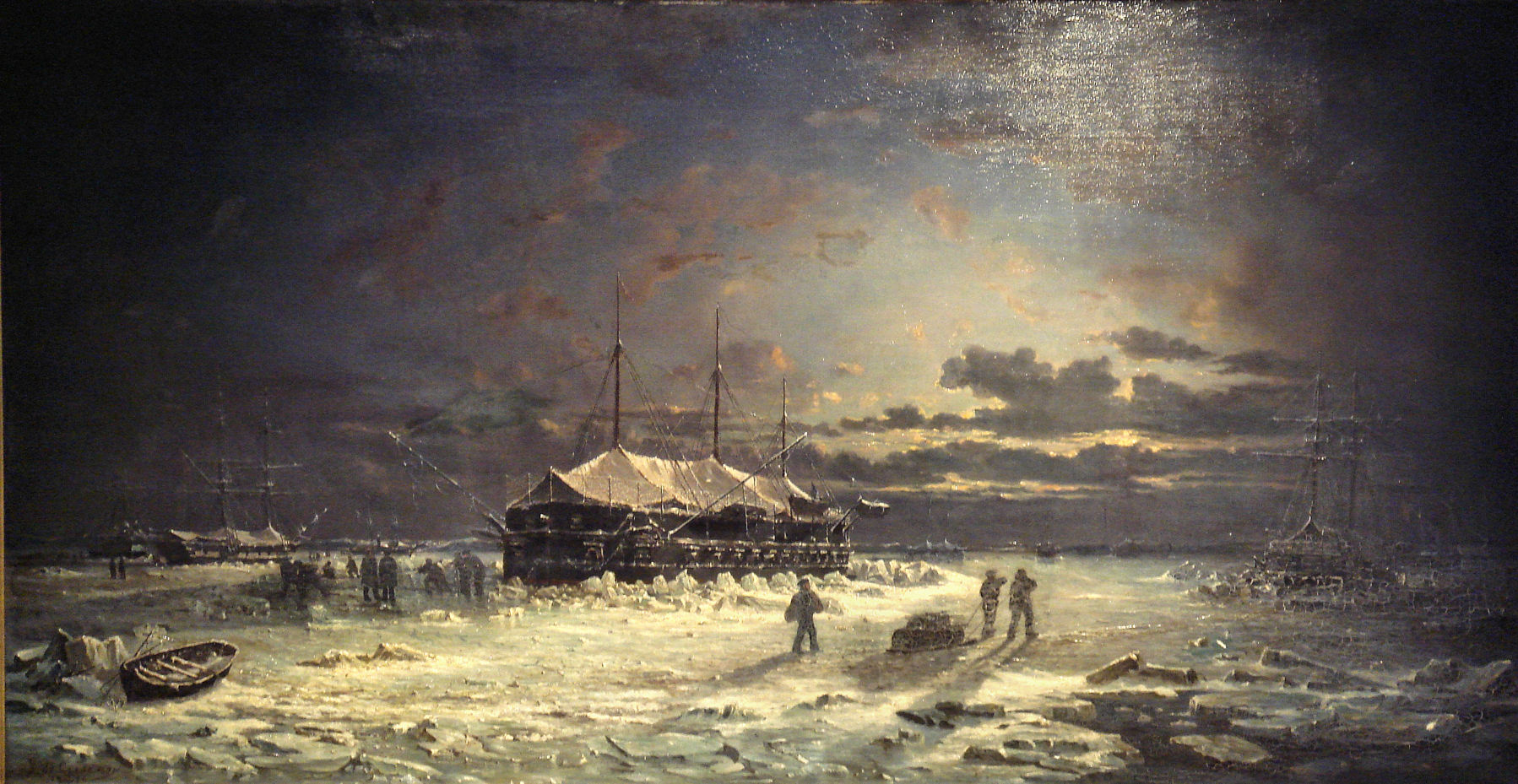Floating Battery on:
[Wikipedia]
[Google]
[Amazon]



 A floating battery is a kind of armed watercraft, often improvised or experimental, which carries heavy armament but has few other qualities as a
A floating battery is a kind of armed watercraft, often improvised or experimental, which carries heavy armament but has few other qualities as a


 A floating battery is a kind of armed watercraft, often improvised or experimental, which carries heavy armament but has few other qualities as a
A floating battery is a kind of armed watercraft, often improvised or experimental, which carries heavy armament but has few other qualities as a warship
A warship or combatant ship is a naval ship that is used for naval warfare. Usually they belong to the navy branch of the armed forces of a nation, though they have also been operated by individuals, cooperatives and corporations. As well as b ...
.
History
During the capture of Mahdia in 1550, Spanish captain Garcia de Toledo Osorio built a floating battery to bombard the city. The fortified, nine-gun battery was built over two galleys and became decisive to take the position. Use oftimber rafts
Timber rafting is a method of transporting felled tree trunks by tying them together to make rafts, which are then drifted or pulled downriver, or across a lake or other body of water. It is arguably, after log driving, the second cheapest mean ...
loaded with cannon by Danish defenders of Copenhagen against bomb ketches of a combined British-Dutch-Swedish fleet is attested by Nathaniel Uring in 1700.
In 1727, Spanish engineer Juan de Ochoa proposed King Philip V Philip V may refer to:
* Philip V of Macedon (221–179 BC)
* Philip V of France (1293–1322)
* Philip II of Spain, also Philip V, Duke of Burgundy (1526–1598)
* Philip V of Spain
Philip V (; 19 December 1683 – 9 July 1746) was List of Sp ...
his project of the ''barcaza-espín'' ("barge-porcupine"), heavily armored floating batteries moved by rows and fitted with multiple ram
Ram, ram, or RAM most commonly refers to:
* A male sheep
* Random-access memory, computer memory
* Ram Trucks, US, since 2009
** List of vehicles named Dodge Ram, trucks and vans
** Ram Pickup, produced by Ram Trucks
Ram, ram, or RAM may also ref ...
s. The end of the Anglo-Spanish War, however, buried the project before it could be implemented.
An early appearance was in 1782 at the Great Siege of Gibraltar
The Great Siege of Gibraltar was an unsuccessful attempt by Enlightenment in Spain, Spain and Kingdom of France, France to capture Gibraltar from the Kingdom of Great Britain, British during the American Revolutionary War. It was the largest ba ...
, and its invention and usage is attributed to French engineer Jean Le Michaud d'Arçon
Jean Claude Eléonore Le Michaud d’Arçon (18 November 1733 – 1 July 1800) was a French general, specializing in fortification. His designs include the forts at Pontarlier and Fort-Dauphin in Queyras.
Life Early life
He was the son of a la ...
.
A purpose-built floating battery was ''Flådebatteri No. 1'', designed by Chief Engineer Henrik Gerner
Henrik Gerner (1742–1787) was a Danish naval officer who specialised in shipbuilding and naval architecture. His interests as an entrepreneurial engineer led to unsinkable gun platforms, horse-driven dredging machines, and desalination equipme ...
in 1787; it was long, wide and armed with 24 guns, and was used during the 1801 Battle of Copenhagen under the command of Peter Willemoes. The British made limited use of floating batteries during the French Revolutionary and Napoleonic Wars
{{Infobox military conflict
, conflict = Napoleonic Wars
, partof = the French Revolutionary and Napoleonic Wars
, image = Napoleonic Wars (revision).jpg
, caption = Left to right, top to bottom:Battl ...
, with the two-vessel and -class floating batteries, and some individual vessels such as .
The most notable floating batteries were built or designed in the 19th century, and are related to the development of the first steam warship and the ironclad warship
An ironclad was a steam-propelled warship protected by steel or iron armor constructed from 1859 to the early 1890s. The ironclad was developed as a result of the vulnerability of wooden warships to explosive or incendiary shells. The firs ...
.
''Demologos
''Demologos'' was the first warship to be propelled by a steam engine. She was a wooden floating battery built to defend New York Harbor from the Royal Navy during the War of 1812. The vessel was designed to a unique pattern by Robert Fulton, an ...
'', the first steam-propelled warship, was a floating battery designed for the protection of New York Harbor
New York Harbor is a bay that covers all of the Upper Bay. It is at the mouth of the Hudson River near the East River tidal estuary on the East Coast of the United States.
New York Harbor is generally synonymous with Upper New York Bay, ...
in the War of 1812
The War of 1812 was fought by the United States and its allies against the United Kingdom of Great Britain and Ireland, United Kingdom and its allies in North America. It began when the United States United States declaration of war on the Uni ...
.
In the 1850s, the British and French navies deployed iron-armoured floating batteries as a supplement to the wooden steam battlefleet in the Crimean War
The Crimean War was fought between the Russian Empire and an alliance of the Ottoman Empire, the Second French Empire, the United Kingdom of Great Britain and Ireland, and the Kingdom of Sardinia (1720–1861), Kingdom of Sardinia-Piedmont fro ...
. The role of the battery was to assist unarmoured mortar and gunboats bombarding shore fortifications. The French used their batteries in 1855 against the defenses at Kinburn on the Black Sea
The Black Sea is a marginal sea, marginal Mediterranean sea (oceanography), mediterranean sea lying between Europe and Asia, east of the Balkans, south of the East European Plain, west of the Caucasus, and north of Anatolia. It is bound ...
, where they were effective against Russian shore defences. The British planned to use theirs in the Baltic Sea
The Baltic Sea is an arm of the Atlantic Ocean that is enclosed by the countries of Denmark, Estonia, Finland, Germany, Latvia, Lithuania, Poland, Russia, Sweden, and the North European Plain, North and Central European Plain regions. It is the ...
against Kronstadt
Kronstadt (, ) is a Russian administrative divisions of Saint Petersburg, port city in Kronshtadtsky District of the federal cities of Russia, federal city of Saint Petersburg, located on Kotlin Island, west of Saint Petersburg, near the head ...
, and may have been influential in causing the Russians to sue for peace.Lambert A., "Iron Hulls and Armour Plate"; Gardiner, ''Steam, Steel and Shellfire'', pp. 47–55 However, Kronstadt was widely regarded as the most heavily fortified naval arsenal in the world throughout most of the 19th-century, continually upgrading its combined defences to meet new changes in technology. Even as the British armoured-batteries were readied against Kronstadt in early 1856, the Russians had already constructed newer networks of outlying forts, mortar batteries of their own, and submarine mines against which the British had no system for removing under fire.
Traditional floating battery called kotta mara was used by the Banjar and Dayak against the Dutch during the Banjar war (1859–1906). The battery is made by adding walls (sloped and unsloped) to a raft made by large logs. Some of them shaped like a castle and had bastion
A bastion is a structure projecting outward from the curtain wall of a fortification, most commonly angular in shape and positioned at the corners of the fort. The fully developed bastion consists of two faces and two flanks, with fire from the ...
s with 4 cannons on each bastion. The kotta mara could resist the Dutch 30-pounder cannons until 24.5 m range, the range which the cannon could effectively penetrate it.van Rees, Willem Adriaan (1867). ''De Bandjermasinsche Krijg van 1859-1863 nader toegelicht.'' Arnhem: D.A. Thieme.
Floating batteries were popularly implemented by both the Union and the Confederacy
A confederation (also known as a confederacy or league) is a political union of sovereign states united for purposes of common action. Usually created by a treaty, confederations of states tend to be established for dealing with critical issu ...
during the American Civil War
The American Civil War (April 12, 1861May 26, 1865; also known by Names of the American Civil War, other names) was a civil war in the United States between the Union (American Civil War), Union ("the North") and the Confederate States of A ...
. The first was the Confederate Floating Battery of Charleston Harbor, which took an active part in the bombardment of Fort Sumter in April 1861. Experimental ironclad vessels that proved too cumbersome or were underpowered were often converted into floating batteries and posted for river and coastal waterway control. Here too, Civil War batteries and even ironclads such as the famed monitors
Monitor or monitor may refer to:
Places
* Monitor, Alberta
* Monitor, Indiana, town in the United States
* Monitor, Kentucky
* Monitor, Oregon, unincorporated community in the United States
* Monitor, Washington
* Monitor, Logan County, West ...
, were acutely vulnerable to mines protected in turn by forts. As a result, the combined defences of Charleston, South Carolina, for example, were never overwhelmed by the Union Navy.
See also
* United States floating battery ''Demologos'' *Arsenal ship
An arsenal ship is a concept for a floating missile platform intended to have as many as five hundred vertical launch bays for large-sized missiles, most likely cruise missiles. In current U.S. naval thinking, such a ship would initially be ...
References
Bibliography
* * * {{DEFAULTSORT:Floating Battery Naval artillery Ship types Ship designs of the Spanish Empire